
Under Water & Unaware
Outdated Regulations Leave the Texas Petrochemical Industry Vulnerable to Severe Storms
By Adrian Shelley
ACKNOWLEDGEMENTS
This report was written by Adrian Shelley, director of Public Citizen’s Texas Office, with assistance from Simon Youngbloom. It was edited by Michael Coleman.
Cover image by Adrian Shelley is licensed under Creative Commons.
KEY FINDINGS
Texas regulations have not kept pace with the modern frequency and volume of heavy rain events. The Texas Gulf Coast regularly experiences extreme weather that exceeds worst case predictions and leads to flooding, infrastructure damage, and industrial accidents. Texas must update its regulations with new data to minimize the harm caused by future extreme weather events.
- In Harris County, a 100-year, 24-hour storm is defined as 12 inches and a 25-year, 24-hour storm is defined as 9 inches.
- The Houston region has experienced four 100-year storms and six 25-year storms in the last twenty-two years.
- Texas regulations generally rely on Technical Paper 40, which uses outdated data leading to inadequate definitions for “100-year storm” and “25-year storm.”
- During Hurricane Harvey, at least nine petrochemical facilities experienced floating roof tank failures due to heavy rain, causing them to release a combined three million pounds of air pollution. Updates to regulations related to heavy rain could prevent this pollution.
- The American Petroleum Institute construction standards for floating roof tanks rely on outdated data from Technical Paper 40.
- The U.S. National Oceanographic and Atmospheric Administration has newer rainfall data available in a document known as Atlas 14.
- Updating state regulations with data from Atlas 14 would increase the 25-year storm by 2.6 inches, the 100-year storm by 5 inches, and create a new definition for a 1,000-year storm of 29.8 inches.
- Updated regulations should lead to construction and work practices that better prepare industry for more frequent extreme rainfall events.
INTRODUCTION
Texas has suffered more billion-dollar climate and weather disasters than any other state.1 Since 1980 there have been 291 billion-dollar disasters in the United States, 129 of which have hit Texas. That means nearly half (44 percent) of major U.S. weather disasters harm Texans.
Many of Texas’ most costly—and deadly—storms have been hurricanes. The worst of them have reshaped our understanding of weather extremes. In August 2017, Hurricane Harvey dumped as much as 51 inches of rain on the Texas Gulf Coast. The deluge was so unprecedented that weather maps were changed on the fly to record the event.
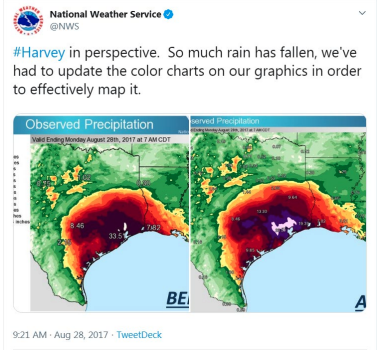
Harvey was an extraordinary hurricane, one the National Hurricane Center called “the most significant tropical cyclone rainfall event in United States history[.]”3 One publication hyperbolically labeled Harvey a once-in-a-half-a-million-years’ event.
In Houston, any storm with at least twelve inches of rain in a 24-hour period is deemed a “100-year storm.” The next 100-year storm would come just two years after Harvey. Tropical Storm Imelda dumped 24 to 26 inches on the Texas Gulf Coast on September 19, 2019. Two other 100-year storms have walloped Houston since 2000, as well as another six 25-year storms.
Climate change has us living in unusual times. The increasing frequency of these supposedly rare rainfall events is not just bad luck. It is a clear sign that our climate is changing and that our assumptions about rainfall frequency and volume are wrong. This report will show that Texas’ definitions of extreme rainfall events—including 100-year and 25-year storms—are outdated and inaccurate.
Public Citizen’s Texas office reviewed state regulations related to rainfall. Our research shows that industries that rely on outdated assumptions about rainfall volume and frequency often contribute to some of the worst environmental pollution during such storms. Moreover, Texas legislators have stubbornly refused to update our laws and regulations to prepare for the impact of climate change. This is part of why our cities and towns in Texas suffer so greatly during severe storms.
Each time we get it wrong, there are grave consequences. Major storms and floods cost dozens of lives, thousands of homes, and billions of dollars in damage. Houston is home to the largest concentration of petrochemical facilities in the United States. As a result, the region is especially vulnerable to catastrophic damage from severe storms and flooding.
It is time to rethink these outdated benchmarks. It is also time to update Texas’ industrial standards for rainfall so infrastructure, such as petroleum tanks, can be designed to a more stringent standard. Ignoring this urgent need will only exacerbate the economic, environmental, and public health problems these storms inflict on Texas.
I. MAJOR RAINFALL EVENTS ON THE TEXAS GULF COAST SINCE 2000 SHOW THAT THE DEFINITIONS OF 25- AND 100-YEAR STORMS ARE OBSOLETE
Rainfall events are defined by their frequency, duration, and volume. A 100-year, 24-hour rainfall event is the maximum amount of rain that should be expected to fall over any 24-hour period during a span of 100 years.
Another way to state this is that a 100-year flood should have a one-in-one-hundred chance (that is, a 1% chance) of occurring in a given year. This will be true whether the last 100-year flood was 1 year ago or 99 years ago. Similarly, a 25-year flood should have a one in twenty-five chance (4%) of occurring in a given year.
In Harris County, a 100-year storm is defined as 12 inches. A 25-year storm is defined as 9 inches. Using these definitions, the Houston region has experienced four 100-year storms and six 25-year storms since 2000.


Note that this list does not include Hurricane Rita, which hit Texas and Louisiana in September 2005 and caused 119 deaths and $25.2 billion in property damage.17 Rainfall totals reached 16 inches in Louisiana but did not meet the 25-year or 100-year storm definitions in Texas.
Together, these storms killed hundreds of people and caused hundreds of billions of dollars in damage. The natural disaster of Hurricane Harvey was followed by a man-made environmental disaster as petrochemical facilities released millions of pounds of unauthorized pollution. If Texas is to avoid these disasters in the future, it must update its assumptions about the size and volume of heavy rainfall in the state.
II. INDUSTRIAL ACCIDENTS AND SEVERE STORMS
Hurricane Harvey’s Unprecedented Rain Overwhelmed Industrial Facilities and led to Large Pollution Releases
Sometimes severe storms in Texas cause major industrial accidents. Hurricane Harvey led to the release of 8.3 million pounds of air pollution and 150 million gallons of wastewater.18 Much of this pollution was from facilities that were overwhelmed by Harvey’s unprecedented rainfall.
The tendency of floating roof petroleum storage tanks to fail under heavy volumes of rain was first identified after Hurricane Harvey. Floating roof tanks are large, cylindrical tanks for storing crude oil or other petroleum products. They have a roof that sits within the tank walls and floats on top of the petroleum products inside. Heavy rain can cause tank roofs to become submerged or flip. Tank roof drains can become overwhelmed or clogged. All these failures can lead to massive discharges of pollution.
At least nine companies experienced storage tank failures due to excessive rain during Hurricane Harvey. These failures resulted in the release of more than three million pounds of air pollution. A summary of these events as reported to the TCEQ’s Air Emissions Event Reporting Database is below.
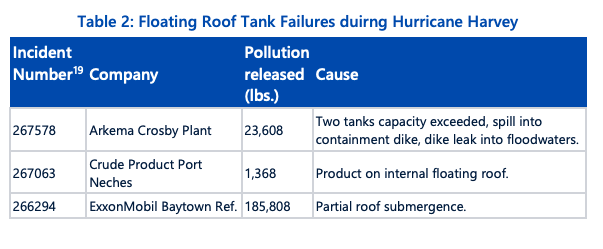
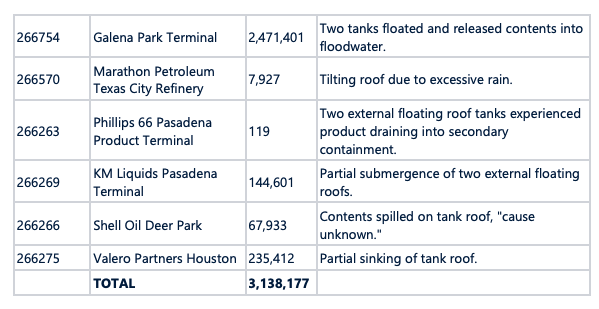
Over time, the environmental fallout from Hurricane Harvey became more widely known.20 The Texas House of Representatives Committee on Environmental Regulation held a hearing on April 25, 2018, to take testimony on Harvey response and cleanup efforts.21 At that hearing, Harris County Pollution Control Services Director Bob Allen gave testimony, as did others. 22
Text BoxMr. Allen testified about an apparent weakness in the design of floating roof tanks. There are roughly 400 external floating roof tanks in Harris County. The county identified nine tank failures during Harvey and questioned the tank owners about a cause. Some companies responded that the drains on the roofs of their floating roof tanks were too small. Mr. Allen testified that while industry standard is a four-inch drain, companies with six-inch drains on their tanks did not experience tank failures during Harvey, even after forty-five inches of rain. Notably, the largest single event during Hurricane Harvey, the Galena Park Terminal release, was not due to a drain failure, but to floodwaters causing tanks to float.
In his testimony, Mr. Allen recommended that new tanks be required to have larger drains, and that existing tanks could be required to enlarge their tank drains during their next turnaround.
The drain size of floating roof tanks is not proscribed by TCEQ,23 which has not established construction standards for oil and gas infrastructure. The controlling authority is the American Petroleum Institute Standard 650: “Welded Tanks for Oil Storage” API Standard 650, Eleventh Edition, June 2007 (citing authority form 40 CFR 195.132(b)(3), Design and construction of aboveground breakout tanks).
API 650 speaks to floating roofs, rainfall, and drains twice:
“Floating roofs shall have sufficient buoyancy to remain afloat…for the following conditions: (a) 250 mm (10 in.) of rainfall in a 24-hour period” API 650, C.3.4.1 (2007).
“Emergency Roof Drains…shall be sized to handle the rainfall specified by the Purchaser.” API 650, C.3.8.2 (2007).
API 650 says nothing about roof drain sizes of four inches or otherwise. There is further discussion of industry standards in Part VI below.
Given Houston’s record of storms since 2000, the guideline to construct for “10 in. of rainfall in a 24-hour period” is clearly out of date. The rainfall assumptions in API 650 come from “Technical Paper Number 40, Rainfall Frequency Atlas of the United States.”25 Technical Paper 40 or “TP-40” was published in May 1961 by the Weather Bureau of the U.S. Department of Commerce and relies on rainfall data from 1938 to 1958.26
Tank Failures also occurred before Hurricane Harvey
Hurricane Harvey was the first time that the systemic weakness of petroleum storage tanks to high volumes of rain was recognized.27 There had, however, been similar incidents previously reported to the TCEQ. During the April 18, 2016 “Tax Day Flood,” the Nustar Logistics Texas City Crude Tank Farm experienced tank rain failures leading to 5,136 pounds of pollution. The side drains in Tank 84 became plugged. Tank 85, which was not in service at the time, was hampered by a faulty roof drain.28
During the “Memorial Day Flood” of May 25-26, 2015, two reported incidents were directly attributed to rainfall. At the Phillips 66 Pasadena Product Terminal, Tank 120 released 3,238 pounds of pollution due to a floating roof drain failure.29 Nine inches of rain fell overnight, leading to a drain clog likened to “leaves clogging a rain gutter.” Water accumulated on the roof, causing one side of the external floating roof to sink into the gasoline stored within. Gasoline then floated to the top of the rain on the tank roof and was released into the air.
Also, during the Memorial Day Flood, the Magellan Pipeline Terminals East Houston Tank Farm released 34,836 pounds of pollution from Tank 1222. Eleven inches of rain caused the external floating roof tank to submerge, forcing petrochemicals onto the roof.30
Storms have also caused air pollution releases from sources other than tanks. The Halloween Flood of 2015 led to a power outage31 and an emergency shutdown/startup.32 A storm on July 17, 2012, caused an emergency shutdown at the Pasadena Refinery, where a power failure led to “heavy flaring” and the release of nearly a half million pounds of pollution.33
Although most of the pollution incidents in this report are from tanks due to rain volume, a few other common causes are apparent. Severe storms regularly cause power failures and emergency shutdowns that lead to large releases of pollution. Power outages are common during storms, and emergency backup power could blunt their impact. Emergency shutdowns can be prevented by shutting down safely before a storm makes landfall.
Since Hurricane Harvey, other storms have led to the release of considerable amounts of pollution. More than two dozen facilities reported releases after Hurricane Laura, totaling 768,882 pounds of pollution (although nearly half of that was carbon dioxide pollution from one incident). Notably, pollution from facility shutdown and startup exceeded pollution from accidental “upset” events. This means that companies emitted more pollution preparing for the storm than they did in accidents caused by the storm.
Facility startups and shutdowns often release copious amounts of pollution. The decision to shut down or ride out a storm is a difficult one. But when it is made hastily, the potential for large-scale pollution increases. We recommend plant managers decide early, leaving enough time to shutdown safely before the storm hits.
III. STATE REGULATIONS ARE BASED ON OUTDATED DATA
Texas’ petrochemical industry is unprepared for severe rainfall because our laws and regulations have not kept pace with our new climate reality. Climate change has led to more water vapor in the air, which in turn leads to heavier rain.34 Texas policy makers have obstinately refused to plan for climate change. Our regulations related to severe rainfall are hopelessly outdated. Texas must update these regulations to reduce the petrochemical industry’s vulnerability to future storms.
Many of Texas’ construction standards, control technologies, and work practices are based on definitions such as “100-year storm,” “25-year storm,” and “100-year flood plain.” Technical Paper 40 is the most cited source in Texas regulations for these definitions. It defines a 100-year, 24-hour storm in Houston as one with 12 inches of rain. A 25-year, 24-hour storm has just 9 inches of rain.
TP-40 is not the most current source for these definitions. On September 27, 2018, The National Oceanographic and Atmospheric Association (NOAA)35 published “NOAA Atlas 14, Volume 11 Precipitation-Frequency Atlas of the United States, Texas,” known as “Atlas 14.”36
When releasing Atlas 14, NOAA acknowledged that major rainstorms are getting larger. NOAA explained that it, “finds significantly higher rainfall frequency values in parts of Texas, redefining the amount of rainfall it takes to qualify as a 100-year or 1000-year event.”37
Atlas 14 defines a 100-year storm in Houston as 17 inches and a 25-year storm as 11.6 inches. Atlas 14 also introduces a new category of event: the 1,000-year storm, which brings 29.8 inches of rain. A comparison of these two sources gives a vastly different picture of how much rain Houston can expect:
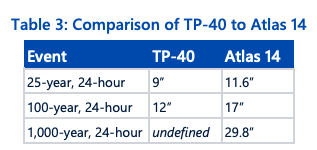
Although Atlas 14 is the newest dataset available, it still relies on the North American Datum of 1983.38 Using the definitions in Atlas 14, Houston would have experienced, since 2000, three 25-year storms, one 100-year storm, and three 1000-year storms.
Even though Atlas 14 data is itself data, adopting the Atlas 14 definitions would be a significant improvement over current regulation. As the following map shows, an update from TP-40 to Atlas 14 would add several inches to the 100-year storm definition across south Texas:
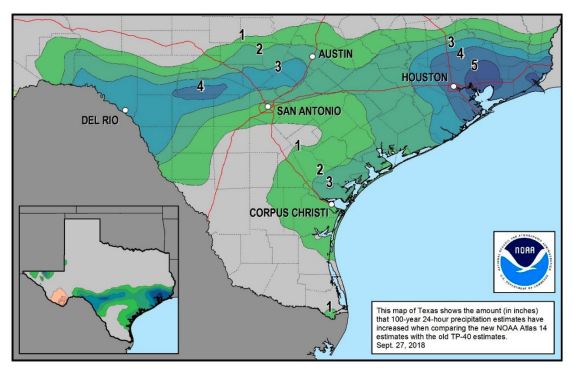
Another comparison of TP-40 to Atlas 14 is included as Appendix A to this report. Public Citizen overlaid the 25-year and 100-year rainfall event maps in from TP-40 and Atlas 14. These combined maps provide a detailed comparison of rainfall event definitions across Texas from these two sources.
IV. TWO IMPORTANT STATE AGENCIES HAVE OUTDATED REGULATIONS
Industries regulated by the Railroad Commission and the Texas Commission on Environmental Quality are at risk due to outdated regulations that use old rainfall data.
Two state agencies—the Railroad Commission and the Texas Commission on Environmental Quality—have the majority of regulatory references to rainfall volumes. Both agencies rely most frequently on Technical Paper-40 for data supporting their regulations. TP-40 was issued in 1961 and relies on rainfall data from 1938 to 1958.
Texas is the largest petrochemical producing state in the United States. The petrochemical industry is regulated by the both the Railroad Commission of Texas and the Texas Commission on Environmental Quality. These two state agencies enact regulations that rely on outdated data about rainfall frequency and volumes. As a result, the petrochemical industry is not being adequately protected from the risk of extreme weather events.
The Railroad Commission of Texas
Title 16, Part 1 of the Texas Administrative Code covers the Railroad Commission of Texas, which is Texas’ oil and gas regulatory agency. The Railroad Commission references 10-year and 100-year storms but does not cite any authority for the size of rainfall events. The Railroad Commission discusses flood plain maps in several chapters and sites to the Federal Emergency Management Agency (FEMA).
In Chapter 3, authorized pits40 may not be located within the 100-year flood plain without approval by the district director.41 The “100-year flood plain” is defined by reference to FEMA maps or U.S. Department of Agriculture soil maps.
Chapter 4 defines the “100-year flood plain” as “An area that is inundated by a 100-year flood, which is a flood that has a one percent or greater chance of occurring in any given year.”43 Subchapter B of Chapter 4 covers commercial oil and gas waste recycling facilities, which should not be in the 100-year flood plain.44 Permits for on-site commercial oil and gas waste recycling must include a stormwater runoff plan that protects against a 25-year, 24-hour rainfall.45
Chapter 12 covers surface mining activities. Hydrologic balance is maintained in part with stream diversions, which must be designed to pass runoff from a 10-year, 6-hour precipitation event for temporary diversions and a 100-year, 6-hour event for permanent diversions.46 Surface water runoff from valley fills must pass runoff from a 100-year, 24-hour event.
Finally, the timeline for the extended responsibility period for a revegetation project is based in part on an area’s rainfall total, specifically whether it receives more or less than 26 inches of rain a year. This regulation does not include a map of these areas or any other reference.
The Texas Commission on Environmental Quality
TCEQ regulations, found in Title 30 of the Texas Administrative Code, usually cite Technical Paper-40 for definitions of rainfall. A representative example is the definition of a “25-year, 24-hour rainfall event” found in Title 30 of the Texas Administrative Code, Chapter 312, “Sludge Use, Disposal, and Transportation”:49
25-year, 24-hour rainfall event–The maximum rainfall event with a probable recurrence interval of once in 25 years, with a duration of 24 hours as defined by the National Weather Service in Technical Paper Number 40, Rainfall Frequency Atlas of the United States, May 1961, and subsequent amendments, or equivalent regional or state rainfall information developed from it.
There are two references in TCEQ’s code to Technical Paper 49, both in the subchapter on Concentrated Animal Feeding Operations. In one instance, the definition of “Design rainfall event” references Technical Paper 40 or 49.50 The other reference is in a definition of “25-year, 10-day event:”51
Twenty-five-year, ten-day rainfall event–The maximum rainfall event with a probable recurrence interval of once in 25 years, with a duration of ten days, as defined by the National Weather Service in Technical Paper Number 49 United States Weather Bureau and United States Department of Agriculture, Two-to-Ten Day Precipitation for Return Periods of 2 to 100 Years in the Contiguous United States (1964); or equivalent regional or state rainfall information.
TP-49 was published in 1964 and is also outdated. Appendix B includes a plain language explanation TCEQ regulations referencing rainfall events and definitions.
Other state agencies also rely on outdated regulations.
There are a few other state agencies with regulations that are similarly outdated. Several state agencies refer to FEMA maps of the 100-year flood plain that are often themselves dated.
The Texas Department of Agriculture restricts eligibility for disaster relief funds based on a property’s location in the flood plain. Specifically, no funds will be awarded under FEMA’s Hazard Mitigation Grant Program for buyouts of properties that were constructed or purchased after being officially mapped and included in a designated flood plain area.52
The Coastal Coordination Advisory Committee has policies for construction and operation of solid waste treatment storage and disposal facilities. These facilities should not be located in a 100-year floodplain as mapped by the Federal Emergency Management Agency.53 If a hazardous waste landfill is located in a special hazard area, it must be designed to withstand a 100-year flood event. The size of a 100-year flood event is undefined.
Rainfall events in the Houston area since 2000 show that TP-40’s definitions are outdated. They lead to Houston having experienced four 100-year storms and six 25-year storms since 2000. This is an absurd result that will likely only continue as climate change makes extreme weather events more common.
The failure to properly define large rainfall events has grave consequences for public health and safety. During Hurricane Harvey, three million pounds of air pollution was released by floating roof tanks overwhelmed by rain. This may be the largest and most high profile such event, but regulations across Texas suffer from inadequate definitions of extreme rain events.
We recommend that the Texas Administrative Code be updated to use definitions of extreme rain events from Atlas 14 or a subsequent authority. Doing so will increase the size of events, particularly the 25-year and 100-year storm, which would increase on the Gulf Coast by 2.6 and 5 inches, respectively. These more robust definitions should lead to construction and operation of facilities that can withstand large rain events.
V. AMERICAN PETROLEUM INSTITUTE STANDARDS ARE NOT PROTECTIVE BECAUSE THEY ALSO RELY ON OUTDATED ASSUMPTIONS
Industry standards established by the American Petroleum Institute also rely on the outdated assumptions in Technical Paper 40 regarding rainfall frequency.
Neither the Railroad Commission nor the Texas Commission on Environmental Quality have regulations concerning the construction of petrochemical facilities. The American Petroleum Institute has developed industry standards that have been incorporated by reference into the Code of Federal Regulations. API Standard 650 applies to Welded Steel Tanks for Oil Storage.54
API Standard 650 relies on Technical Paper 40 for its assumptions about rainfall volume and frequency.55 Appendix C of Standard 650 is for external floating roof tanks. The design criteria for floating roof tanks recommend they be built to remain afloat during 250 mm (10 inches) of rainfall in a 24-hour period.56 The standard states that, “This condition does not apply to double-deck roofs provided with emergency drains designed to keep water to a lesser volume that the roofs will safely support. Such emergency drains shall not allow the product to flow onto the roof.”57
The primary roof drain of a floating roof tank is intended to safely drain accumulated rainwater from the roof of the tank. API Standard 650 states that:
Primary roof drains shall be sized and positioned to accommodate the rainfall rates specified on the Data Sheet, Line 33, while preventing the roof from accumulating a water level greater than design, without allowing the roof to tilt excessively or interfere with its operation.
API Standard 650 provides a Data Sheet for purchasers to use to standardize specifications when requesting bids from contractors. API Standard 650 provides guidance for filling out the Data Sheet; Line 33 covers details for external floating roofs. The following guidance is provided on rainfall:
- Design Rainfall Intensity: Specify a rainfall rate, a minimum period of duration, and an association with a statistically occurring storm such as that found in Technical Report No. 40 (e.g., 0.5 in. per hour for 5 minutes for the 2-year storm).
- Design Accumulated 24-hour Rainfall: Specify height of water accumulated in 24 hours associated with a statistically occurring storm (e.g., 12 in. in 24 hours for the 100-year storm). See C.3.4 for minimum requirements.
Line 33 of the Data Sheet appears as follows:

A purchaser completing the Data Sheet must specify design rainfall intensity in inches per hour (or millimeters per hour), the duration of the rainfall intensity, and the frequency of the storm. The purchaser must specify design accumulated 24-hour rainfall in inches (or millimeters) and the frequency of the storm. So, the Data Sheet requires purchasers to assume the volume and frequency of rainfall events. The guidance for completing the Data Sheet refers to TP-40.
Double-deck roofs are equipped with emergency drains. API Standard 650 dictates that emergency roof drains should be, “designed to provide drainage to prevent sinking the roof during severe rainfall events.”61 API Standard 650 does not define “severe rainfall events,” stating instead that, “The drains shall be sized to handle the rainfall specified by the Purchaser, with a minimum diameter of NPS 4.”62
“NPS 4” is Nominal Pipe Size 4, which has an outer diameter of 4.500 inches. 63 API Standard 650 dictates that NPS 4 pipe have a thickness dictated by Schedule 40S, which is 0.237 inches.64 This means that emergency roof drains must have a minimum inner diameter of 4.263 inches.
CONCLUSION
Hurricane Harvey showed the consequences of failing to prepare for severe storms. Although the vulnerability of floating roof petroleum storage tanks was unknown before 2017, there is no longer any excuse not to prepare the industry for a future of larger, more intense storms.
As this survey of state regulations has shown, there are many industries that rely on outdated assumptions about rainfall volume and frequency. Texas lawmakers have steadfastly refused to update our laws and regulations to prepare for the impact of climate change. Our vulnerability to severe storms is one consequence of this refusal.
The sheer number of so-called 25-year and 100-year storms that Texas has experienced since 2000 shows that these terms are outdated and based on faulty assumptions. Updating these definitions is one way to prepare for even more extreme weather resulting from climate change.
Just as the National Weather Service has redrawn its maps, it is time for Texas to redefine extreme weather. We recommend that all state codes that reference rainfall frequency and volume be updated to include definitions that cite Atlas 14. Specifically, we recommend definitions such as the following:
25-year, 24-hour rainfall event–The maximum rainfall event with a probable recurrence interval of once in 25 years, with a duration of 24 hours as defined by the National Oceanographic and Atmospheric Association in “NOAA Atlas 14, Volume 11 Precipitation-Frequency Atlas of the United States, Texas” or equivalent regional or state rainfall information.
APPENDIX A: TP-40 AND ATLAS 14 COMPARISON
The maps below compare the 25-year and 100-year storm definitions from Atlas 14 and TP-40. Atlas 14 numbers are represented as colored areas with rainfall totals shown as black numbers. The older numbers from TP-40 are shown as black bars with white numbers in black circles.
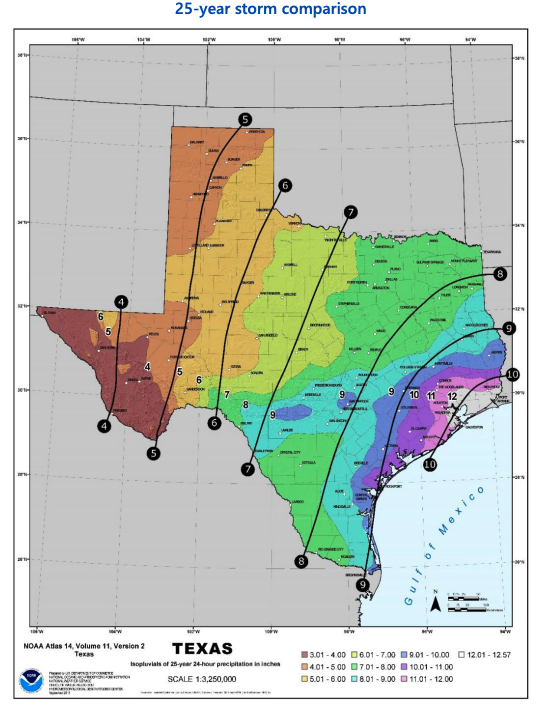
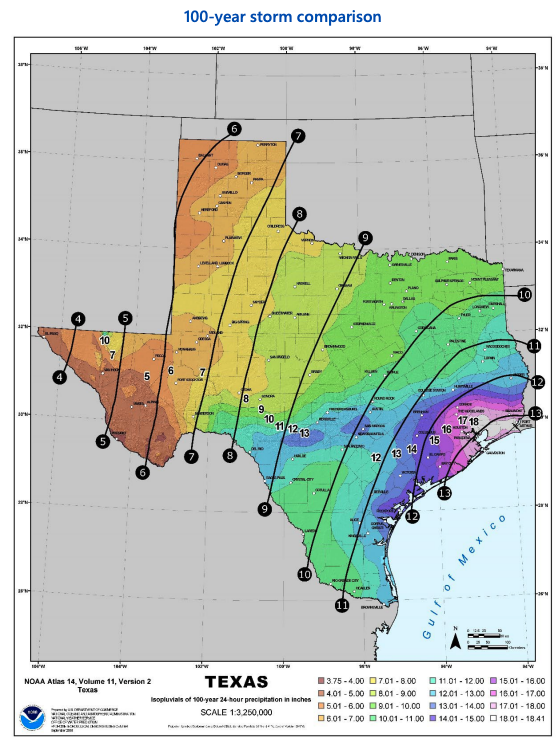
APPENDIX B: TEXAS COMMISSION ON ENVIRONMENTAL QUALITY RAINFALL REGULATIONS
This appendix includes a plain-language explanation of rainfall regulations in use by the Texas Commission on Environmental Quality.
Chapter 217: Design Criteria for Domestic Wastewater Systems
The design criteria for domestic wastewater systems uses TP-40 to define “twenty-five year, 24-hour rainfall event.” This definition is used three times:
- A lift station site must be accessible by truck during all weather conditions, including a 25-year, 24-hour rainfall event.
- A wastewater treatment facility must be accessible by truck during all weather conditions, including a 25-year, 24-hour rainfall event.
- An evaporative lagoon system must be sized to account for the influent flows and precipitation from a 25-year frequency, one-year rainfall event.
Chapter 218: Brine Evaporation Pits
Storm water retention ponds must be capable of containing the volume of storm water runoff from brine product handling areas generated from a 24-hour, 25-year storm.69 Within the 100-year floodplain, facilities must be equipped with stormwater diversion structures capable of accommodating the 24-hour, 25-year storm.
Chapter 309: Domestic Wastewater Effluent Limitation and Plant Siting
In a chapter regulating land application of sewage effluent, the design criteria for irrigation application systems include a requirement for effluent storage. The code gives detailed instructions for determining storage requirements:
The storage requirements shall be based on a design rainfall year with a return frequency of at least 25 years (the expected 25 year-one year rainfall, alternately the highest annual rainfall during the last 25 years of record may be used) and a normal monthly distribution, the application rate and cycle, the effluent available on a monthly basis, and evaporation losses.
Chapter 311: Watershed Protection, Subchapter H: Regulation of Quarries in the John Graves Scenic Waterway
A “25-year, 24-hour rainfall event” is defined with reference to TP-40.72 This definition is used twice:
- There is an exemption from effluent limitations for discharges from quarries resulting from a rainfall event greater than the 25-year, 24-hour rainfall event.
- The final control structure for wastewater and stormwater must be designed to impound the volume of water resulting from a 25-year, 24-hour rainfall event.
Chapter 312: Sludge Use, Disposal, and Transportation
A “25-year, 24-hour rainfall event” is defined with reference to TP-40.75 The definition is used once: the runoff collection system for an active sludge unit must have the capacity to handle runoff from a 25-year, 24-hour rainfall event.
Chapter 321: Control of Certain Activities by Rule
Chapter 321 of Title 30 of the Texas Administrative Code is an assortment of regulations for operations not found elsewhere in the code. The chapter includes several definitions of rainfall events. Both a “twenty-five-year, 24-hour rainfall event”77 and a “10-year, 24-hour precipitation event”78 are defined with reference to TP-40.
As discussed above, Chapter 321 includes regulations for Concentrated Animal Feeding Operations and the only two references to Technical Paper 49 in state code. These references are in the definition of “twenty-five-year, ten-day rainfall event”79 and the definition of “design rainfall event.” The following operations are controlled by Chapter 321.
Concentrated Animal Feeding Operations
The operator of the CAFO shall design, construct, operate, and maintain retention control structures to contain all wastewater including the runoff and direct precipitation from the 25-year, 24-hour rainfall event for the location of the facility.81 The control facility design requirements for CAFOs contain numerous references to the “design rainfall event” and the “25-year, 24-hour rainfall event.”
Meat Processing
Any holding facility shall be designed and operated to retain all rainwater which would enter the holding facilities as a result of a 25-year, 24-hour rainfall.
Wastewater must be isolated from outside surface drainage by diversion structures designed to be effective during peak flows of a 25-year, 24-hour rainfall event.
Surfacing Coal Mining
Any retention pond or series of ponds shall be designed to treat at least the volume of water caused by a 10-year, 24-hour precipitation event.85
Any discharge or increase in volume of a discharge caused by precipitation of greater than the 10-year, 24-hour precipitation event or series of events shall, at a minimum, comply with the following limitations instead of the otherwise applicable limitations: pH within the range of 6.0 to 9.0 standard units at all times.86
Chapter 324: Used Oil Standards
Used oil handling facilities must be equipped with secondary containment facilities with sufficient freeboard to contain the precipitation from a 25-year, 24-hour rainfall event.
Chapter 326: Medical Waste Management
The owner or operator of a medical waste facility must complete a surface water drainage report that certifies that the facility will be constructed to manage “run-on and run-off during the peak discharge of a 25-year rainfall event.” The facility must also either be located outside the 100-year floodplain or be able to prevent washout of waste during a 100-year storm event.
Chapter 330: Municipal Solid Waste
Contaminated water and leachate may be collected and stored in a collection unit other than a storage tank. These units must include one foot of freeboard to accommodate a 25-year, 24-hour rainfall event.
Storage and transfer units and surface impoundments must be designed to withstand a 25-year, 24-hour rainfall event.
Chapter 331: Underground Injection Control
Injection wells located in flood-prone areas include certain additional completion requirements. A “flood-prone area” is defined with reference to FEMA Flood Hazard Maps of the 100-year and 50-year flood plains.
Chapter 332: Composting
Composting facilities must be constructed to protect surface water. Construction, maintenance, and operations must manage run-on and run-off from a 25-year, 24-hour rainfall event.93
Chapter 335: Industrial Solid Waste and Municipal Hazardous Waste
Certain standards apply when the leachate or run-off from a waste pile is a hazardous waste. A run-on control system must prevent flow on the active portion of the waste pile during a 100-year storm. A run-off management system must collect and control the water from a 24-hour, 100-year storm.
Storage or processing facilities, land treatment facilities, and waste piles may not be located in the 100-year floodplain unless they are designed to prevent the physical transport of hazardous waste during a 100-year flood event.95
APPENDIX C: TEXAS ADMINISTRATIVE CODE REFERENCES TO RAINFALL EVENTS
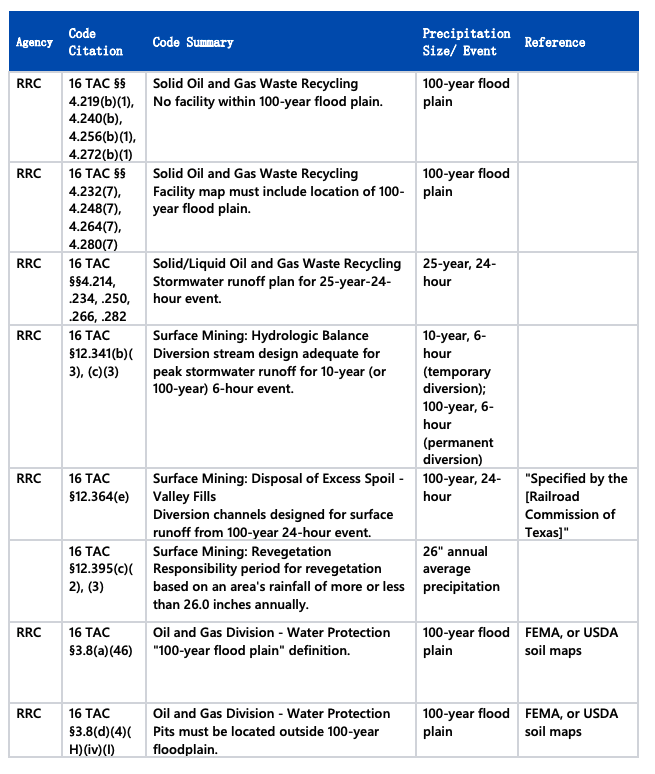
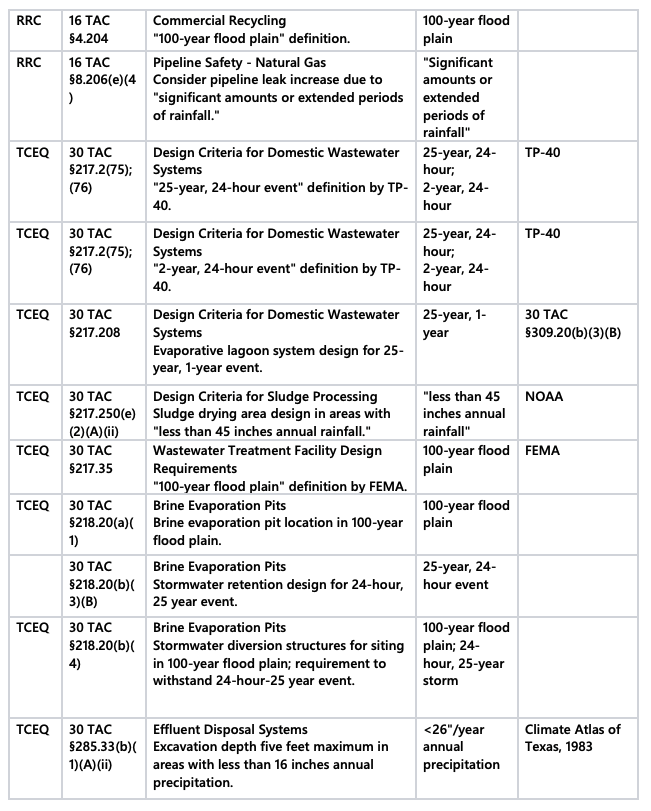
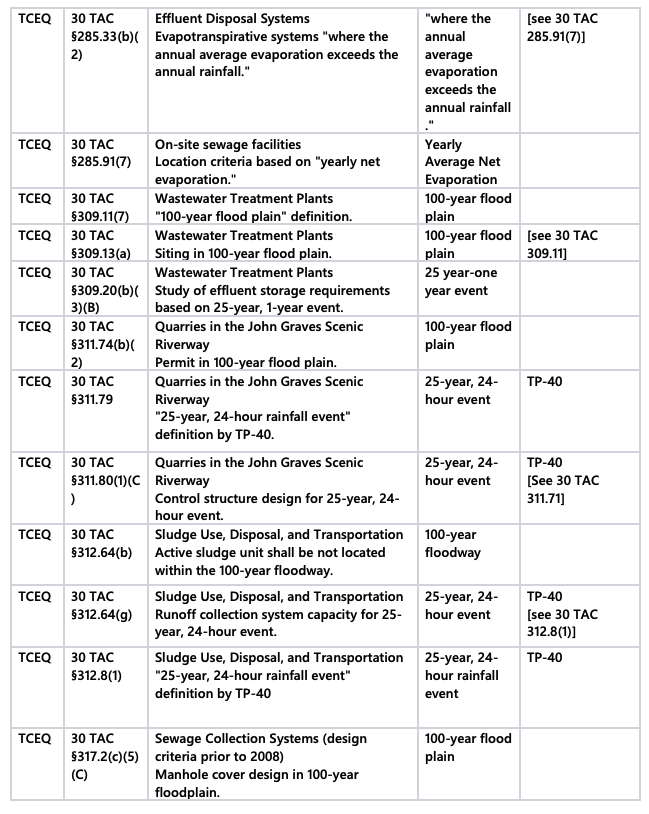
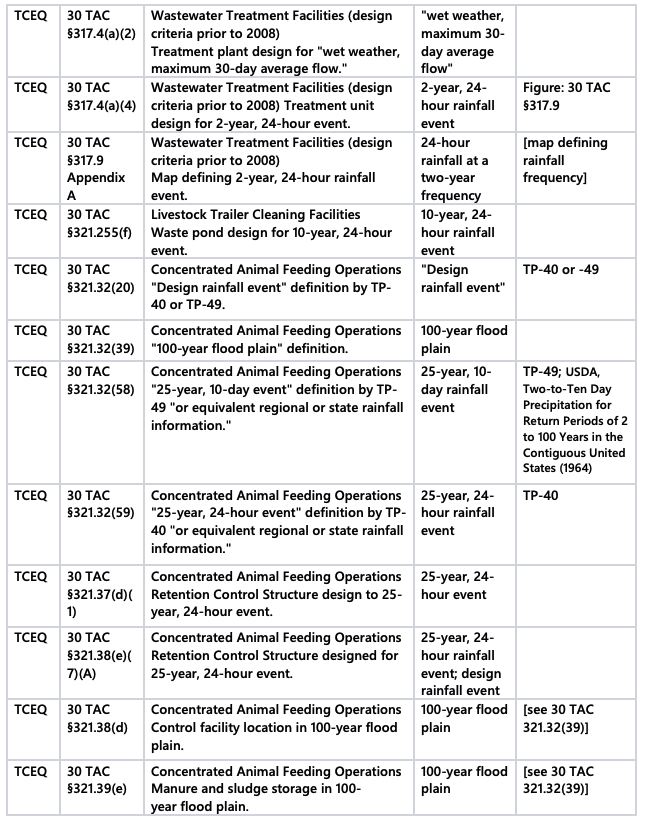
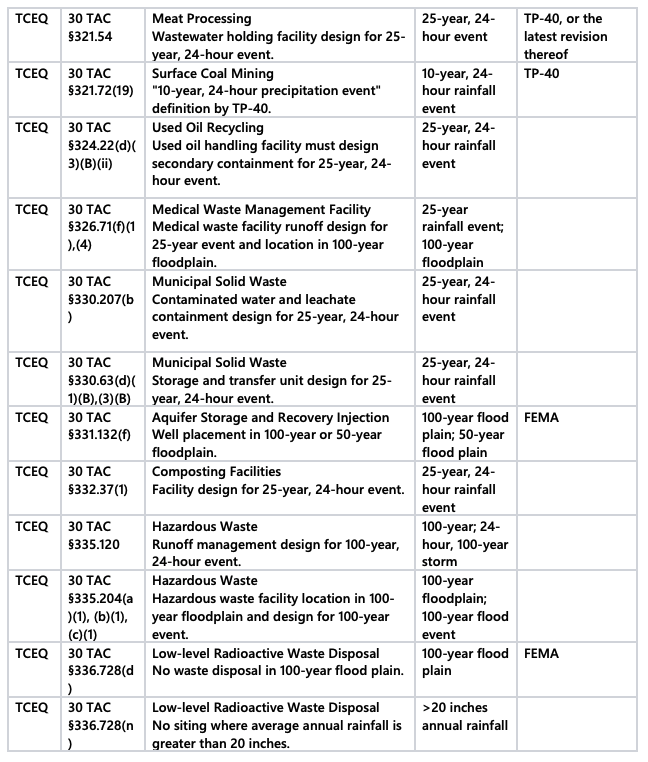

Chapter 336: Radioactive Substance Rules
Low-level radioactive waste may not occur in the 100-year flood plain.96 The disposal site for near-surface land disposal of low-level radioactive waste may not be in a county in which the average annual rainfall is greater than 20 inches.97